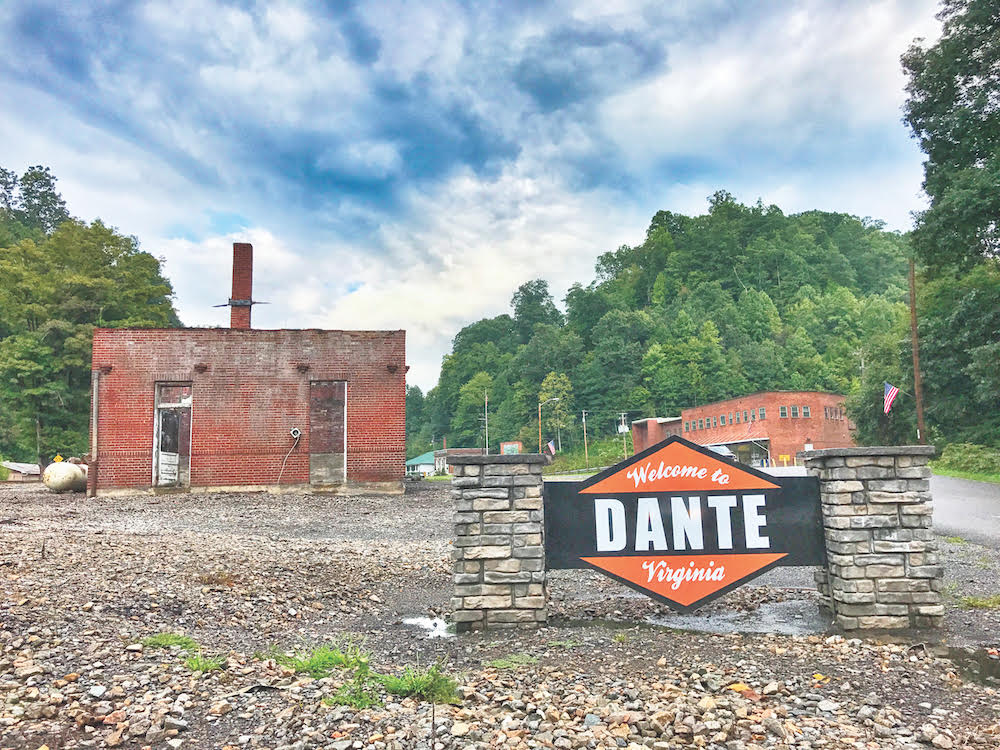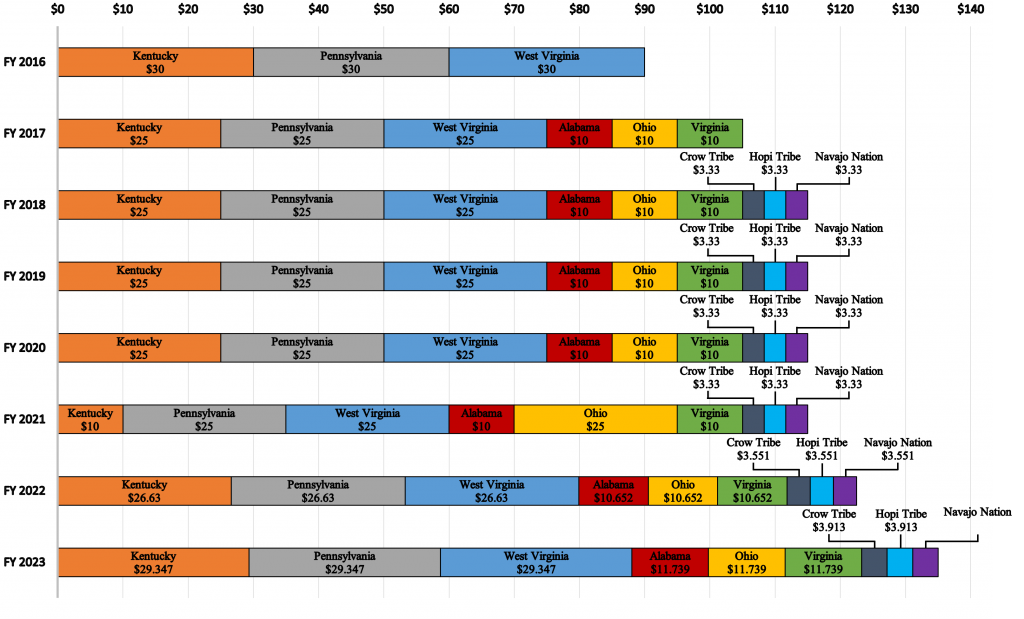Front Porch Blog

The town of Dante, former headquarters of the Clinchfield Coal Corporation, has received a number of grants, including from the AMLER program, to spur economic development while preserving the town’s history. Photo courtesy of Dante Community Association
When the Office of Surface Mining Reclamation and Enforcement released this latest round of funding in March, the agency also released new guidance that responds to the concerns raised by advocates such as the Reclaiming Appalachia Coalition in recent years (see the coalition’s 2022 report, a letter to Congress and set of recommendations).
This year, Congress has expanded the program to its largest budget to date, $135 million. It now serves the six Appalachian states (West Virginia, Virginia, Pennsylvania, Ohio, Alabama and Kentucky) and the three tribes (Hopi, Navajo and Crow) with the most abandoned mine land.

A proposal to transform this mine yard in Marianna, Pennsylvania, into a multi-modal trailhead and memorial to 154 miners killed in a 1908 mine explosion would be funded in part by an AMLER grant. Photo provided by the town of Marianna
The program, originally known as the AML Pilot program, was launched in 2015 and grew out of a pillar of former President Barack Obama’s POWER+ Plan. But the program has a checkered history, with many community groups concerned about projects being approved without community input and politicians using the funds for political favors.
“If there’s not as much public outreach, I think it leans more towards a political decision to fund certain projects — or it comes down to pure nepotism,” said Joey James, a principal with Downstream Strategies, a consulting firm that provides technical support to the Reclaiming Appalachia Coalition and numerous communities applying for AML Pilot funding.

Source: OSMRE
With member organizations across multiple states, the Reclaiming Appalachia Coalition has witnessed how different approaches by the states have led to disparate outcomes. Following lengthy conversations with organizations involved in AMLER projects across Appalachia, the coalition assembled recommendations to ensure that AMLER funding is accessible and transformative for the disadvantaged communities most in need. The coalition has lobbied both Congress and the Office of Surface Mining Reclamation and Enforcement for years to make changes to the program.
“Because the AMLER program is specifically targeted to disadvantaged, coal-impacted communities, it is especially important that the program is implemented in such a way maximizes the creation of good jobs and boosts locally-rooted industries, while remediating the environmental damage from past extractive industry,” Marissa Lautzenheiser, Director of Northern Programs at Rural Action, told Appalachian Voices in a 2022 interview.
New guidance
Now with new guidance from OSMRE, the coalition is celebrating progres it has made with the agency.
Among the changes, OSMRE added new recommendations for states and tribal agencies and grant applicants to demonstrate and solicit public engagement and support. This includes recommendations that the state or tribal agency incorporate input from disadvantaged communities, communities of color, low-income communities, and tribal and Indigenous communities into their prioritization criteria and methods for selecting projects to be funded. The guidance also includes new language defining a “disadvantaged community” for the purposes of meeting Justice40 goals, ensuring 40% of certain government funding reaches disadvantaged communities.
A community may be considered disadvantaged based on a number of factors, including the following factors: low income, high and/or persistent poverty; high unemployment and underemployment; racial and ethnic residential segregation, particularly where the segregation stems from discrimination by government entities; linguistic isolation; high housing cost burden and substandard housing; distressed neighborhoods; high transportation cost burden and/or low transportation access; disproportionate environmental stressor burden and high cumulative impacts; limited water and sanitation access and affordability; disproportionate impacts from climate change; high energy cost burden and low energy access; jobs lost through the energy transition; access to healthcare; and geographic areas within Tribal jurisdictions.
The new guidance also prohibits coal companies in violation of the U.S. Surface Mining Control and Reclamation Act from receiving AMLER funds. Because former coal mining sites eligible for the AMLER program are sometimes on property adjacent to current mining operations, some areas targeted for reclamation and new economic development are on land owned by coal companies. Advocates have been concerned about AMLER funds, designed to undo harms caused by the coal industry, going to coal companies, particularly in Virginia.
In recent years, state agencies and grant awardees have been particularly concerned about the delays in grants being approved by OSMRE, as projects get stuck in the agency’s approval process. Though the Reclaiming Appalachia Coalition found the most significant delays for AMLER projects are in the planning phase (due to problems not anticipated by the applicants or states), both state agency staff and community advocates have also pushed for OSMRE to establish standard review timelines to provide some certainty for applicants and the state and tribal agencies implementing the project. The new guidelines include a commitment from OSMRE to provide an initial assessment within 60 days indicating to state and tribal agencies and applicants whether a project can move forward.
OSMRE’s updated guidance also encourages project applicants and federal, state and tribal agencies to conduct more community engagement and consultation around proposed projects. The update allows applicants to use documented community support as a way to demonstrate favorable conditions for economic development. Past guidance limited the options for demonstrating favorable conditions to documentation of the project’s role in the community’s economic development strategy, or documentation of planned economic or community use.
Lastly, the new guidance clarifies matching grant fund requirements, specifying that, while matching funds are not required in order to access the AMLER grants, matching grants are recommended to demonstrate project viability and stakeholder support. This has been an area of confusion and inconsistency across states and tribes implementing the program. Match requirements for federal grant funds are one of the most significant barriers to under-resourced communities attempting to access federal grant programs. The fact that AMLER is one of the few grant programs that does not require a match has made it a more accessible program.
The future of the AMLER program
Despite these improvements, communities still face barriers in accessing the AMLER program. Even the improvements in the new guidance will not be impactful unless the state and tribal agencies implementing AMLER lean in and embrace the suggested improvements around stakeholder engagement and community consultation.
Many of the recommendations put forth by the Reclaiming Appalachia Coalition and other advocates in recent years are still left unaddressed — some that can only be resolved via more direction from Congress and others that would only be feasible for OSMRE to address itself if it had an appointed director. Appalachian Voices and our partners will continue to advocate for improvements to the program to help coal-impacted communities recover and transition from the decline of coal.
Take action now: Tell President Biden: Appoint an OSMRE director!
PREVIOUS
NEXT
Related News

Leave a comment
Your email address will not be published. Required fields are marked *
